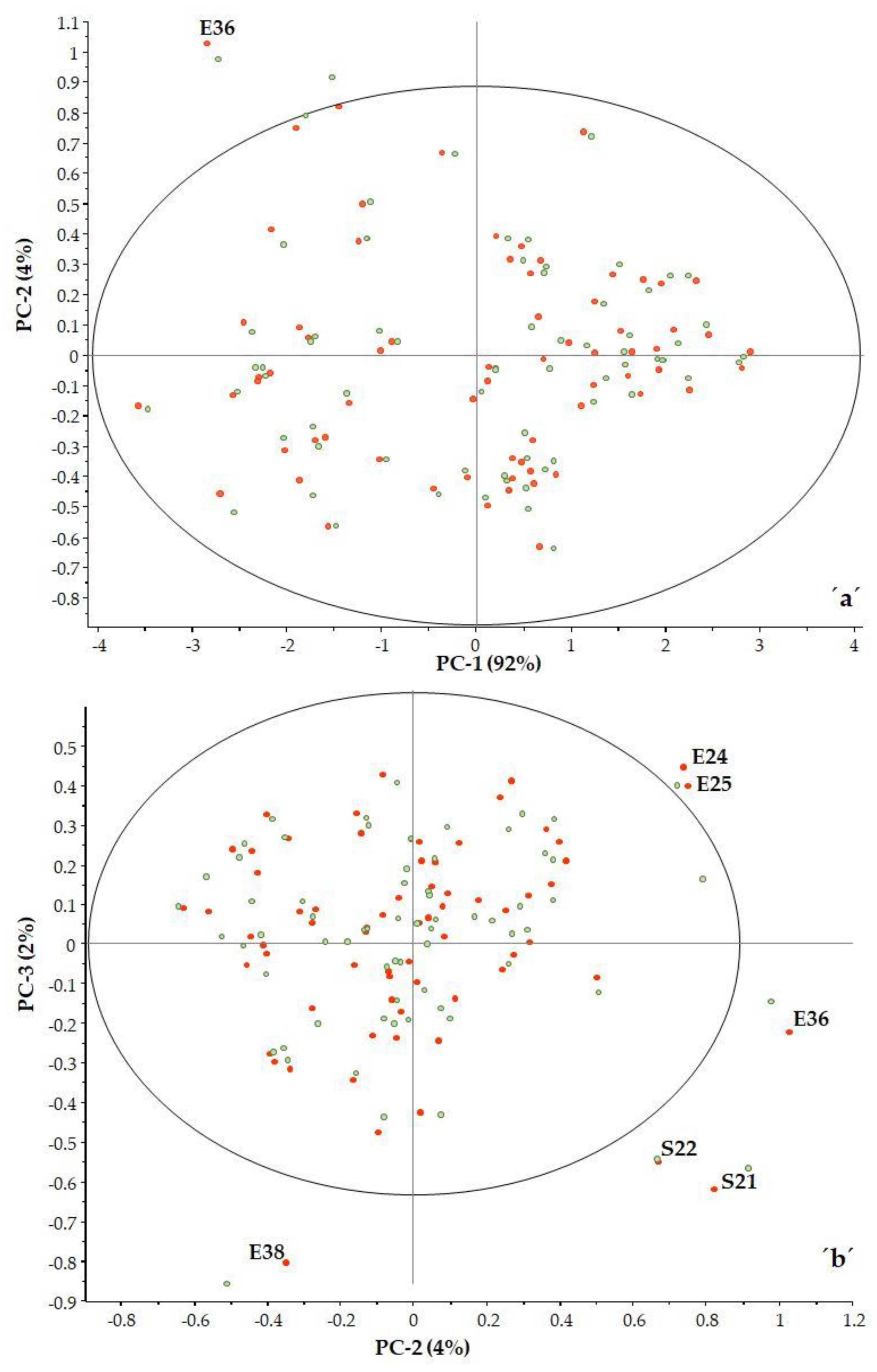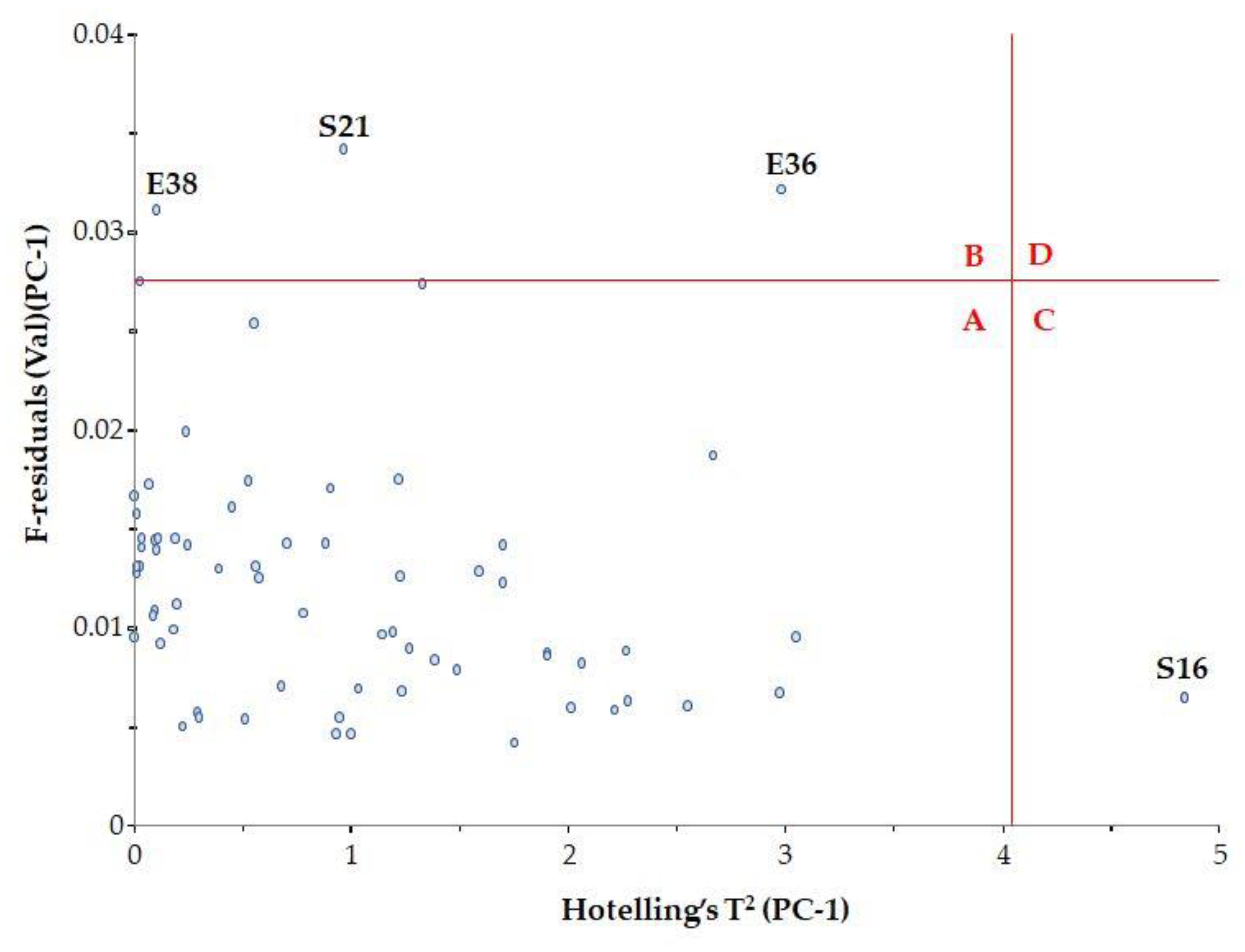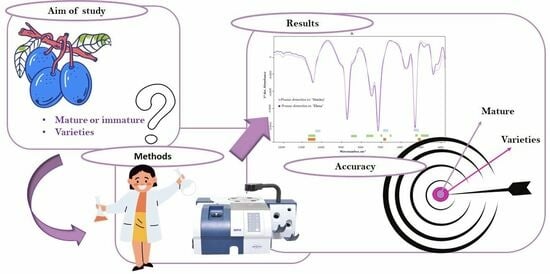Assessment of Maturity of Plum Samples Using Fourier Transform Near-Infrared Technique Combined with Chemometric Methods
Abstract
:1. Introduction
2. Materials and Methods
2.1. Materials
2.2. Methods
2.2.1. Reference Methods
2.2.2. FT-NIR Measurements
2.2.3. Chemometric Methods
Principal Component Analysis—PCA
Partial Least-Squares Regression—PLSR
Classification Models
3. Results
3.1. Reference Data
3.2. NIR Spectra Analysis
3.3. Chemometric Assessment
3.3.1. Principal Component Analysis—PCA
Spectral Data
Reference Data
3.3.2. PLSR Results
3.3.3. Classification Methods
4. Conclusions
Supplementary Materials
Author Contributions
Funding
Data Availability Statement
Acknowledgments
Conflicts of Interest
References
- Milošević, T.; Milošević, N.; Mladenović, J. Diversity of Plums Belonging to P. domestica L., P. insititia L. and Prunus × rossica Erem. Tree Vigour, Yielding and Fruit Quality Attributes. Sci. Hortic. 2023, 320, 112220. [Google Scholar] [CrossRef]
- Johnson, J.B.; El Orche, A.; Naiker, M. Prediction of Anthocyanin Content and Variety in Plum Extracts Using ATR-FTIR Spectroscopy and Chemometrics. Vib. Spectrosc. 2022, 121, 103406. [Google Scholar] [CrossRef]
- Kljusurić, J.G.; Jurina, T.; Valinger, D.; Benkovi, M.; Tušek, A.J. Chapter 8—NIR Spectroscopy and Management of Bioactive Components, Antioxidant Activity, and Macronutrients in Fruits. In Fruit Crops; Srivastava, A.K., Hu, C., Eds.; Elsevier: Amsterdam, The Netherlands, 2020; pp. 95–109. ISBN 978-0-12-818732-6. [Google Scholar]
- FoodData Central. Available online: https://fdc.nal.usda.gov/fdc-app.html#/food-details/169949/nutrients (accessed on 7 June 2023).
- Cabrera-Bañegil, M.; Lavado Rodas, N.; Prieto Losada, M.H.; Blanco Cipollone, F.; Moñino Espino, M.J.; Muñoz de la Peña, A.; Durán-Merás, I. Evolution of Polyphenols Content in Plum Fruits (Prunus salicina) with Harvesting Time by Second-Order Excitation-Emission Fluorescence Multivariate Calibration. Microchem. J. 2020, 158, 105299. [Google Scholar] [CrossRef]
- Monago-Maraña, O.; Domínguez-Manzano, J.; Muñoz de la Peña, A.; Durán-Merás, I. Second-Order Calibration in Combination with Fluorescence Fibre-Optic Data Modelling as a Novel Approach for Monitoring the Maturation Stage of Plums. Chemom. Intell. Lab. Syst. 2020, 199, 103980. [Google Scholar] [CrossRef]
- Monago-Maraña, O.; Cabrera-Bañegil, M.; Rodas, N.L.; Muñoz de la Peña, A.; Durán-Merás, I. First-Order Discrimination of Methanolic Extracts from Plums According to Harvesting Date Using Fluorescence Spectra. Quantification of Polyphenols. Microchem. J. 2021, 169, 106533. [Google Scholar] [CrossRef]
- Pérez-Marín, D.; Paz, P.; Guerrero, J.-E.; Garrido-Varo, A.; Sánchez, M.-T. Miniature Handheld NIR Sensor for the On-Site Non-Destructive Assessment of Post-Harvest Quality and Refrigerated Storage Behavior in Plums. J. Food Eng. 2010, 99, 294–302. [Google Scholar] [CrossRef]
- Paz, P.; Sánchez, M.-T.; Pérez-Marín, D.; Guerrero, J.-E.; Garrido-Varo, A. Nondestructive Determination of Total Soluble Solid Content and Firmness in Plums Using Near-Infrared Reflectance Spectroscopy. J. Agric. Food Chem. 2008, 56, 2565–2570. [Google Scholar] [CrossRef]
- Louw, E.D.; Theron, K.I. Robust Prediction Models for Quality Parameters in Japanese Plums (Prunus salicina L.) Using NIR Spectroscopy. Postharvest Biol. Technol. 2010, 58, 176–184. [Google Scholar] [CrossRef]
- Costa, R.C.; de Lima, K.M.G. Prediction of Parameters (Soluble Solid and PH) in Intact Plum Using NIR Spectroscopy and Wavelength Selection. J. Braz. Chem. Soc. 2013, 24, 1351–1356. [Google Scholar] [CrossRef]
- Zhao, Z.; Wang, Y.; Gong, D.; Niu, X.; Cheng, W.; Gu, Y. Discrimination of Plum Browning with Near Infrared Spectroscopy. Guang Pu Xue Yu Guang Pu Fen Xi 2016, 36, 2089–2093. [Google Scholar]
- Li, M.; Lv, W.; Zhao, R.; Guo, H.; Liu, J.; Han, D. Non-Destructive Assessment of Quality Parameters in ‘Friar’ Plums during Low Temperature Storage Using Visible/near Infrared Spectroscopy. Food Control 2017, 73, 1334–1341. [Google Scholar] [CrossRef]
- Vlaic, R.A.; Mureșan, A.E.; Mureșan, C.C.; Petruț, G.S.; Mureșan, V.; Muste, S. Quantitative Analysis by HPLC and FT-MIR Prediction of Individual Sugars from the Plum Fruit Harvested during Growth and Fruit Development. Agronomy 2018, 8, 306. [Google Scholar] [CrossRef]
- Walsh, K.B.; Blasco, J.; Zude-Sasse, M.; Sun, X. Visible-NIR ‘Point’ Spectroscopy in Postharvest Fruit and Vegetable Assessment: The Science behind Three Decades of Commercial Use. Postharvest Biol. Technol. 2020, 168, 111246. [Google Scholar] [CrossRef]
- Vitalis, F.; Tjandra Nugraha, D.; Aouadi, B.; Aguinaga Bósquez, J.P.; Bodor, Z.; Zaukuu, J.-L.Z.; Kocsis, T.; Zsom-Muha, V.; Gillay, Z.; Kovacs, Z. Detection of Monilia Contamination in Plum and Plum Juice with NIR Spectroscopy and Electronic Tongue. Chemosensors 2021, 9, 355. [Google Scholar] [CrossRef]
- Abasi, S.; Minaei, S.; Jamshidi, B.; Fathi, D. Dedicated Non-Destructive Devices for Food Quality Measurement: A Review. Trends Food Sci. Technol. 2018, 78, 197–205. [Google Scholar] [CrossRef]
- Elena Szilva-Gyümölcspédia. Available online: http://gyumolcspedia.hu/elena-szilva (accessed on 17 July 2023).
- Stanley Szilva-Gyümölcspédia. Available online: http://gyumolcspedia.hu/stanley-szilva (accessed on 17 July 2023).
- Fodor, M. Development of FT-NIR Technique to Determine the Ripeness of Sweet Cherries and Sour Cherries. Processes 2022, 10, 2423. [Google Scholar] [CrossRef]
- Brereton, R.G. Introduction to Statistical, Algorithmic and Theoretical Basis of Principal Components Analysis. J. Chemom. 2022, 36, e3406. [Google Scholar] [CrossRef]
- Minasny, B.; McBratney, A.B. Why You Don’t Need to Use RPD. Pedometron 2013, 33, 14–15. [Google Scholar]
- Chang, C.-W.; Laird, D.A.; Mausbach, M.J.; Hurburgh, C.R. Near-Infrared Reflectance Spectroscopy–Principal Components Regression Analyses of Soil Properties. Soil Sci. Soc. Am. J. 2001, 65, 480–490. [Google Scholar] [CrossRef]
- Naes, T.; Isaksson, T.; Fearn, T.; Davies, T. A User-Friendly Guide to Multivariate Calibration and Classification; NIR Publications: Chichester, UK, 2004; ISBN 978-1-9067-1525-0. [Google Scholar]
- Vandeginste, B.G.M.; Massart, D.L.; Buydens, L.M.C.; De Jong, S.; Lewi, P.J.; Smeyers-Verbeke, J. Multivariate Calibration. In Data Handling in Science and Technology; Elsevier: Amsterdam, The Netherlands, 1998; Volume 20, pp. 349–381. ISBN 978-0-444-82853-8. [Google Scholar]
- Esbensen, K.H.; Geladi, P. Principles of Proper Validation: Use and Abuse of Re-Sampling for Validation. J. Chemom. 2010, 24, 168–187. [Google Scholar] [CrossRef]
- Gere, A.; Danner, L.; de Antoni, N.; Kovács, S.; Dürrschmid, K.; Sipos, L. Visual Attention Accompanying Food Decision Process: An Alternative Approach to Choose the Best Models. Food Qual. Prefer. 2016, 51, 1–7. [Google Scholar] [CrossRef]
- Nazeer, S.S.; Sreedevi, T.P.; Jayasree, R.S. Autofluorescence Spectroscopy and Multivariate Analysis for Predicting the Induced Damages to Other Organs Due to Liver Fibrosis. Spectrochim. Acta A Mol. Biomol. Spectrosc. 2021, 257, 119741. [Google Scholar] [CrossRef] [PubMed]
- Chicco, D.; Jurman, G. The Advantages of the Matthews Correlation Coefficient (MCC) over F1 Score and Accuracy in Binary Classification Evaluation. BMC Genom. 2020, 21, 6. [Google Scholar] [CrossRef] [PubMed]
- Vitanova, I.M.; Dimkova, S.D.; Ivanova, D.A. Chemical and Technological Characteristics of Plum Cultivars. Acta Hortic. 1998, 309–312. [Google Scholar] [CrossRef]
- Bohačenko, I.; Pinkrová, J.; Komárková, J.; Paprštein, F. Selected Processing Characteristics of New Plum Cultivars Grown in the Czech Republic. Hortic. Sci. 2010, 37, 39–45. [Google Scholar] [CrossRef]
- Bilal, W.; Bhutta, M.; Rehman, K.; Ahmad, N.; Awan, A.A.; Hussain, B.; Bacha, Z.; Rehman, F.; Naeem, A.; Shoaib, Q.; et al. Physical and Chemical Attributes of Various Cultivars of Plum Fruit. Pure Appl. Biol. 2015, 4, 353–361. [Google Scholar] [CrossRef]
- Master List of Typical PH and Acid Content of Fruits and Vegetables for Home Canning and Preserving. Available online: https://pickyourown.org/ph_of_fruits_and_vegetables_list.htm (accessed on 15 June 2023).
- Stellina Marfa. What Is the pH Level of Plums? Available online: https://stellinamarfa.com/fruits/what-is-the-ph-level-of-plums/ (accessed on 15 July 2023).
- Ciurczak, E.W.; Igne, B.; Workman, J.; Burns, D.A. Handbook of Near-Infrared Analysis. Practical Analysis, 4th ed.; CRC Press: Boca Raton, FL, USA, 2021; ISBN 978-1-138-57648-3. [Google Scholar]
- Weyer, L.G.; Lo, S.-C. Spectra- Structure Correlations in the Near-Infrared. In Handbook of Vibrational Spectroscopy; Wiley: Hoboken, NJ, USA, 2006; pp. 1817–1837. ISBN 978-0-470-02732-5. [Google Scholar]
- Workman, J.; Weyer, L. Practical Guide and Spectral Atlas for Interpretive Near-Infrared Spectroscopy, 2nd ed.; CRC Press: Boca Raton, FL, USA, 2012; ISBN 978-1-4398-7526-1. [Google Scholar]






| Components | Amount, Unit | Components | Amount, Unit |
|---|---|---|---|
| Water * | 84 g | Energy ** | 38 kcal/159 kJ |
| Ash * | 0.37 g | Protein * | 0.7 g |
| Carbohydrate ** | 9.6 g | Total lipid (fat) * | 0 g |
| Fiber, total dietary * | 2.1 | Starch * | 0 g |
| Total sugar * | 9.92 g | Vitamin content * | |
| Sucrose * | 1.57 g | Thiamin | 0.028 mg |
| Glucose * | 5.07 g | Riboflavin | 0.026 mg |
| Fructose * | 3.07 g | Niacin | 0.417 mg |
| Galactose * | 0.14 g | Pantothenic acid | 0.135 mg |
| Mineral content * | Vitamin C | 9.5 mg | |
| Ca | 6 mg | Vitamin B6 | 0.029 mg |
| Fe | 0.17 mg | Vitamin B12 | 0 |
| Mg | 7 mg | Vitamin A | 17 μg/345 IU |
| P | 16 mg | Vitamin E (α-tocopherol) | 0.26 mg |
| K | 157 mg | Vitamin K (phylloquinone) | |
| Zn | 0.1 mg | 6.4 μg | |
| Cu | 0.057 mg | ||
| Mn | 0.052 mg | ||
| β-Carotene * | 190 μg | Lutein + zeaxanthin * | 73 μg |
| SFA ** | 17 mg | MUFA ** | 134 mg |
| 16:0 | 14 mg | 16:1 | 2 mg |
| 18:0 | 3 mg | 18:1 | 132 mg |
| PUFA 18:2 ** | 44 mg |
| Parameters | Measured Concentration Range | Reference Data for Ripe Fruit | Reference |
|---|---|---|---|
| DM; % w/w | 16.32–28.61 | 13.47–16.49 | [30,31,32] |
| TA; % w/w | 0.50–1.70 | 0.91–0.98 | |
| TSS; % w/w | 7.90–19.40 | 9.77–16.38 | |
| TSS/TA | 5.20–38.80 | 13.22 | |
| pH | 2.95–3.99 | 2.8–3.4 | [33,34] |
| Parameter | Sample Number | Calibration | PC | Cross-Validation | Data Preprocessing | ||||
|---|---|---|---|---|---|---|---|---|---|
| R2 | RMSEE | Q2cv | RMSECV | RPDCV | Bias | ||||
| DM | 68 | 0.925 | 0.54 | 9 | 0.865 | 0.66 | 2.73 | −0.0119 | SNV + FD |
| TA | 0.976 | 0.05 | 8 | 0.950 | 0.07 | 4.48 | 0.0023 | ||
| TSS | 0.986 | 0.42 | 10 | 0.951 | 0.72 | 4.51 | 0.0223 | ||
| MI = TSS/TA | 0.987 | 0.79 | 9 | 0.955 | 1.39 | 4.70 | 0.0031 | ||
| Parameter | Sample * Number | Calibration | PC | Test Validation | Data Preprocessing | ||||
| R2 | RMSEE | Q2p | RMSEP | RPDP | Bias | ||||
| DM | 48/20 | 0.946 | 0.50 | 9 | 0.882 | 0.65 | 2.92 | −0.0413 | SNV + FD |
| TA | 0.977 | 0.06 | 8 | 0.949 | 0.07 | 4.43 | −0.0042 | ||
| TSS | 0.991 | 0.35 | 10 | 0.965 | 0.61 | 5.33 | −0.0105 | ||
| MI = TSS/TA | 0.976 | 1.12 | 9 | 0.951 | 1.50 | 4.70 | −0.086 | ||
| Parameter | Mature | Immature |
|---|---|---|
| TA; %, w/w | ≤1.00 | >1.00 |
| TSS; %, w/w | ≥10.0 | <10.0 |
| TSS/TA | ≥10.0 | <10.0 |
| Mature | Immature | Accuracy | Precision | Sensitivity | Specificity | Classification Method | |||
| % | |||||||||
| Titratable acidity (TA) %, w/w | |||||||||
| Mature | 47 | 0 | 100.0 | 100 | 100 | 100 | MDA QDA | ||
| Immature | 0 | 21 | 100 | 100 | 100 | ||||
| Total Soluble Solid Content (TSS) %, w/w | |||||||||
| Mature | 48 | 0 | 100 | 100 | 100 | 100 | LDA, MDA; QDA | ||
| Immature | 0 | 20 | 100 | 100 | 100 | ||||
| Maturity index = TSS/TA | |||||||||
| Mature | 48 | 0 | 100 | 100 | 0 | 100 | 0 | 100 | LDA, MDA; QLDA |
| Immature | 0 | 20 | 100 | 0 | 100 | 0 | 100 | ||
| Cultivars | |||||||||
| Elena | Stanley | Accuracy | Precision | Sensitivity | Specificity | Classification method | |||
| Elena | 38 | 0 | 97.06 | 100 | 100 | 100 | LDA, MDA; QDA | ||
| Stanley | 0 | 30 | 100 | 100 | 100 | ||||
Disclaimer/Publisher’s Note: The statements, opinions and data contained in all publications are solely those of the individual author(s) and contributor(s) and not of MDPI and/or the editor(s). MDPI and/or the editor(s) disclaim responsibility for any injury to people or property resulting from any ideas, methods, instructions or products referred to in the content. |
© 2023 by the authors. Licensee MDPI, Basel, Switzerland. This article is an open access article distributed under the terms and conditions of the Creative Commons Attribution (CC BY) license (https://creativecommons.org/licenses/by/4.0/).
Share and Cite
Fodor, M.; Jókai, Z.; Matkovits, A.; Benes, E. Assessment of Maturity of Plum Samples Using Fourier Transform Near-Infrared Technique Combined with Chemometric Methods. Foods 2023, 12, 3059. https://doi.org/10.3390/foods12163059
Fodor M, Jókai Z, Matkovits A, Benes E. Assessment of Maturity of Plum Samples Using Fourier Transform Near-Infrared Technique Combined with Chemometric Methods. Foods. 2023; 12(16):3059. https://doi.org/10.3390/foods12163059
Chicago/Turabian StyleFodor, Marietta, Zsuzsa Jókai, Anna Matkovits, and Eszter Benes. 2023. "Assessment of Maturity of Plum Samples Using Fourier Transform Near-Infrared Technique Combined with Chemometric Methods" Foods 12, no. 16: 3059. https://doi.org/10.3390/foods12163059








